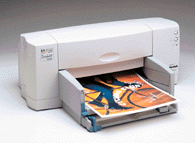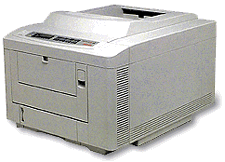 TechnoFILE's Printer Buyers Guide
TechnoFILE's Printer Buyers Guide
We point you in the
Right Direction
So much for the paperless
office, eh? Despite the promises, most people find they're using as much
- or more - paper as ever, so you need a peripheral to get your computer-generated
work from PC to page. This isn't necessarily a bad thing: today's printers
have gotten so good that, depending upon the job you're doing, you can
now print in house jobs that once had to be farmed out.
Still, there are many
ways of getting your print job done, from the old dot matrix printers
to the latest color lasers. But which is best for you?
Well, as usual, it
depends on the job you're doing and how much money you have to spend.
There are three basic
types of printers that are meant to be used in today's home and small-businesses:
Laser Printers, Inkjet Printers, and the venerable dot matrix. While the
latter unit is pretty old fashioned, technologically speaking, it can
still have a place, as you'll see a little bit further on in this guide.
 Laser (and/or LED) printers
Laser (and/or LED) printers
These popular beasts
produce a full page at a time using what's basically an offshoot of photocopier
technology. Instead of merely aping an existing image, however, these
printers use a laser beam or light-emitting diode (LED) to "carve" the
image onto a light-sensitive drum. From there, the image is transferred
onto your sheet of paper by fusing toner to the page at a relatively high
temperature - which explains why the pages are hot when they come out
of a laser printer.
Laser printers are
priced anywhere from around $400 to $10,000 (for a really, really high
end model). The more you spend, the faster and better the printer will
be - plus you can take advantage of options like network connectivity,
improved graphics and a heavier duty operating cycle.
Laser printers have
traditionally been fast; low end models generally crank out four pages
per minute, while the biggies used in office networks can spit out up
to 24 pages in that time - which is really moving! A reasonable average
for mid range laser printers is 6-8 PPM.
Even low-end laser
printers can produce nice, sharp text and graphics - though that also
depends upon the software package you're using (some high end ones require
you to have a "PostScript" card installed; more about that later). High-end,
specialty printers can rival the imagesetters used by magazines and newspapers.
Right now, laser printers
are best if you're satisfied with black and white or grayscale output.
Color laser printers are still high end - which means expensive. They're
sure nice, though! If you do buy a color laser printer, you'll be pleased
as punch to see color quality as good as the best inkjets, though it still
isn't quite as good as high-end specialty color printers. For now, however,
most mortals who need color will be more than happy with an inkjet - at
least until it's time to replace your ink cartridges, which are generally
more pricey over the long haul than laser printers' toner cartridges.
Inkjet printers
Inkjet printers do
their magic by squirting ink through tiny nozzles, a line at a time, onto
the page. Until recent years, the quality one got from an inkjet printer
wasn't up to business use, but - that being then and now being now - they've
become almost as good as lasers, whether for text or color graphics.
In fact, with the
right paper and ink cartridges, you can get "near-photographic" quality,
which (when coupled with the comparatively low price of such units) has
led to a huge surge of popularity for inkjet printers.
You can get into a
monochrome inkjet for as little as $150US, with color starting at about
fifty bucks more - though you can spend up to about $2,500 for one that
walks and talks and sings and dances.
As with lasers, the
extra dollars buys more speed, better quality (and better color), sharper
text and the capacity to handle large-format paper sizes.
Inkjet printers are
less expensive to get into than most laser printers, especially when it
comes to color printing. And you can get amazingly good printed color
from even a fairly entry level color inkjet, which makes it a nice tool
- not only for home businesses, but for families with children as well.
Adding a scanner or
digital camera to the mix gives you incredible flexibility.
Inkjets are slower
than comparable (entry level vs. entry level, high end vs. high end) laser
printers, and they aren't really suited for high-volume work. You can
do high volume work, but the cost of the ink cartridges will put you into
the poor house. Inkjets' print quality is less consistent than lasers'
, and even the best ones won't give you images as sharp as those produced
by lasers. You also need to let the pages dry; otherwise the print may
smear if rubbed - even against another page. Newer generations of inkjets
- and inks - have made this less of a problem than in years past, but
you should still be aware of it.
Dot matrix printers
Remember them? Once
virtually ubiquitous, these noisy little beasties have nearly disappeared
from the consumer market (in favor of inkjet and laser printers). Dot
matrix printers work by striking an inked ribbon with tiny wires on a
print head passing over a page a line at a time.
There are still advantages
to dot-matrix printers, however, especially for businesses. For example,
they're the only printers that can handle pin-fed ("tractor feed"), multicopy
forms (invoices, purchase orders, etc.). On the other hand, the quality
isn't nearly in the same league as inkjets or lasers - and as mentioned
above they're noisy as the dickens. Still, they can have their place.
There are a couple
of other types of printers available, though they aren't nearly as mainstream.
Color thermal printers
are for high end graphics, and use intense heat to transfer color
from ribbons to specially coated paper. There were a few low end versions
of these a few years ago, but they've been mostly supplanted by inkjets.
Dye sublimation
printers produce pictures that are hard to tell from a photograph
- but you'll want to be a graphics professional with a bank loan to get
one! Even the best of these printers are relatively ponderous and expensive
- to buy and to operate.
Which one's for you?
Some printers are
more designed to handle graphics than text, and vice versa (dot matrix,
for example, is lousy at graphics). Others are better at color than black-and-white,
and vice versa.
Specifications can
help, but they can also give an incomplete picture - and remember, they're
from the manufacturer and are therefore anything but unbiased. Remember,
trust your eyes as the best judge of print quality: it's you who has to
live with it - and it's you who knows what kind of printing you'll be
doing.
Always ask to see
the printer demonstrated, via a sample page printed in front of you.
Here are some other
terms you may run into:
Resolution. Printers
lay down tiny dots of ink, toner or dye. The more - and smaller - the
dots, the better the image quality. This "resolution" is measured in dots
per inch, or "dpi." A printer with a resolution of 300 x 300 dpi can produce
90,000 dots per square inch, which is the minimum for professional-looking
text today. Even better, and more commonly available now, is 600 dpi,
which produces 360,000 dots per square inch.
Most of today's better
laser and inkjet printers are capable of 600 dpi resolution or more. Some
inkjets are better at business graphics and/or text, while others are
designed to print photographs.
Speed. Usually
measured in pages per minute, or "PPM.," laser printers can crank out
from four to 24 PPM., but anything more than eight PPM. will cost you.
Inkjets produce from two to seven pages per minute.
Don't believe manufacturers'
speed ratings, though; they're "best case scenarios" for the most part.
Pages filled
with complex graphics or photos can take a lot longer to print - sometimes
minutes per page. Graphics speed depends on the quality of a printer's
microprocessor, its memory size, and how efficient its software driver
is.
Memory can be a good
indicator of speed when it comes to laser printers: a four Mb printer
generally produces its first page faster than a two Mb printer, and so
on.
Duty cycle. This
means the life you can expect out of the printer before it packs it in
on you. Price is a good rule of thumb here: the more you spend, the longer
the thing'll last. Duty cycle is generally expressed in pages per month,
and if you need a workhorse you'll be doing yourself a disservice by using
a light-duty printer in a heavy-duty environment. Rather than saving a
few bucks, you'll end up spending it on repairs - at the worst possible
moment.
Paper size. Most
home/small-office printers handle standard 8.5-by-11-inch paper. If you
need legal-size paper handling, or use nonstandard-size sheets, you may
need a special paper tray - and not all printers offer them.
Printers also vary
in how well they handle envelopes. Some are child's play, while others
will have you tearing out your hair.
PostScript Printers.
PostScript is really a programming language. Developed by Adobe Systems
Inc., it's meant to guarantee the identical handling of text and graphics
by any printer that has a PostScript interpreter in it, regardless of
manufacturer. PostScript is a standard in the publishing industry, and
PostScript printers are common in offices that need to produce a lot of
graphics. Many companies build two versions of their printers -- with
and without PostScript capability. Naturally, you'll pay more for a PostScript
printer though, since most home and home office users won't need it, it
may not be a priority for you.
Good Luck!.
Tell us at TechnoFile what YOU think


 TechnoFILE's Printer Buyers Guide
TechnoFILE's Printer Buyers Guide Laser (and/or LED) printers
Laser (and/or LED) printers